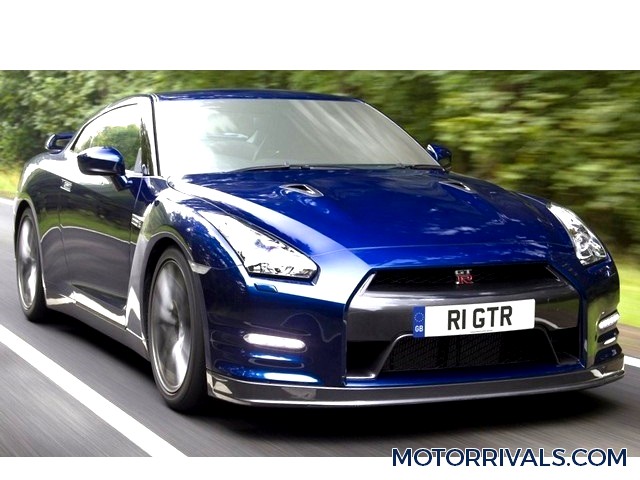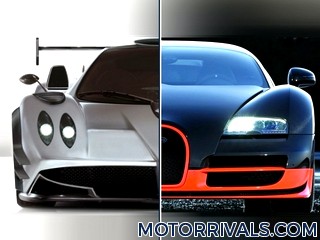2012 Nissan GT-R vs 2011 Porsche 911 Turbo
The 911 was outgunned in 2008 when Nissan released the R35 model of the GT-R (not to mention the Corvette ZR1 and Viper ACR) leading to Porsche's question of Nissan's validity. Back and forth quibbling began with Porsche trying to disprove Nissan's performance claims rather than working on their own. But Porsche is back, this time with a vengeance. The 911 Turbo's engine has been transplanted from the 911 Carrera bumping displacement up to 3.8 liters (versus 3.6 before) and redone to increase horsepower and torque by 20. The result is that the 911 Turbo reaches the magical 500 horsepower mark and 480 lb-ft of torque. Optional overboost pumps torque up to 516 lb-ft for 10 seconds at a time. When mated with Porsche's PDK dual-clutch transmission, the results are phenomenal. It'll run to 60 mph in under 3 seconds and hit a 100 before a Volkswagen Beetle gets to 50.
It's rumored that Porsche was benchmarking the GT-R when redesigning the Turbo's engine but that was the old GT-R. Nissan isn't willing to stand by and let the 911 walk all over it's supercar. They've revised Godzilla's engine with a new 530 horsepower rating (up from 485) even though displacement hasn't changed from 3.8 liters. Torque gets a healthy increase as well now at 448 lb-ft (an increase of 15). The improvements come due to revisions in the intake and exhaust along with other changes to the boost pressure and valve timing.
On paper then, the GT-R and 911 Turbo look evenly matched. Both have 3.8-liters engines (V6 in the GT-R, H6 in the 911) paired with twin-turbochargers which put out 500 or more horsepower. The GT-R has a 30 hp advantage over the 911 Turbo but the 911 Turbo has a 32 lb-ft advantage over the GT-R. Both get all-wheel drive to put down that power and both seat four. The two key differences are the location of the engines (front in the GT-R, rear in the 911 of course) and that the GT-R has nearly 400 pounds of extra weight. A 30 hp advantage isn't enough and the GT-R's power-to-weight ratio falls short. So you would assume that 911 Turbo could outrun the GT-R.
But you'd be wrong. The GT-R will run neck and neck with the 911 Turbo despite the weight penalty. How that's possible is beyond me. Something magical must be happening at take-off to help propel the GT-R to 60 mph in under 3 seconds. Maybe 'Godzilla' isn't just a nickname. Maybe the GT-R really is the reincarnation of the fabled beast that not only terrorizes Japan, but now Germany too. But this isn't Godzilla from 1954. This is Godzilla equipped with modern day weapons. Imagine Godzilla armed with a railgun and turbo jet pack... and is on steroids.
Watching the GT-R take corner after corner is awe-inspiring and frightening at the same time. Taking an S-curve in a GT-R at full speed is a lesson in brutality and enlightenment. And when you watch it take on the most frightening track in the world, the end result is more shocking than a M. Night Shyamalan movie. When the GT-R was redesigned in 2008, Nissan took it to Porsche's backyard and ran the infamous Nürburgring in 7:38 minutes. They went back and shaved another twelve seconds in 2010. And now it's been reported that this new Godzilla will do it in 7:20. The only 911 that can beat it is the $250,000 GT2 RS, and that's only by a couple seconds. The 911 Turbo manages a 7:37 lap time, good enough for 2008 but not enough for 2012.
There's even more to consider when looking at the performance. While the GT-R and 911 Turbo are neck and neck on the drag strip, it's managing to do so at the price of a 911 Carrera which the GT-R will easily outrun and outmaneuver. If price is a concern and the brand is not, it's easy to see a clear winner in terms of performance per dollar.
There are three things that hold the GT-R back from all its deserved glory however. The first is the nameplate. Buyers scoff at the idea of buying anything over fifty grand let alone eighty when it's being sold next to a $10,000 Versa. Secondly, styling inside and out doesn't exactly scream supercar. The exterior serves a purpose and is a study in aerodynamics, not art. Third and lastly is quality. There's nothing wrong with the GT-R's interior quality when you pit it against the Corvette or Viper perhaps but for a world class supercar it falls short.
There is a positive side to these negatives however. The nameplate may be what keeps the price as low as it is. When you look at Porsche's practices of nickel and diming customers into buying thousands of dollars of options that should rightfully be included, I'm rather glad the GT-R remains a Nissan and not an Infiniti or some other luxury spin-off that would inflate costs needlessly.
The design is another aspect which can be seen with pros and cons. While the GT-R takes one or two styling cues from its predecessors, there's no template that the designers must follow like there is with the 911. Nissan is uninhibited by any set in stone design which allowed their engineers to start with a clean slate and eke out every performance gain in the body. Aerodynamic drag for instance has decreased from an already remarkably low drag coefficient to 0.26 versus the 911 Turbo's Cd of 0.31. The body's styling also channels the air around it purposefully to increase downforce.
Should Porsche be worried about their 911 then? Probably not. Yes, the GT-R is more aerodynamic but the design isn't iconic. People will continue to buy the 911 no matter it's price and performance because of it's history, brand recognition, and some buyer's preference for prestige over performance. I think Porsche's pride is more hurt than their profits but if they continue to evolve the 911 to a high standard, there shouldn't be anything to worry about. I like to think that the GT-R is helping those evolutionary steps increase faster than would have otherwise though.





















